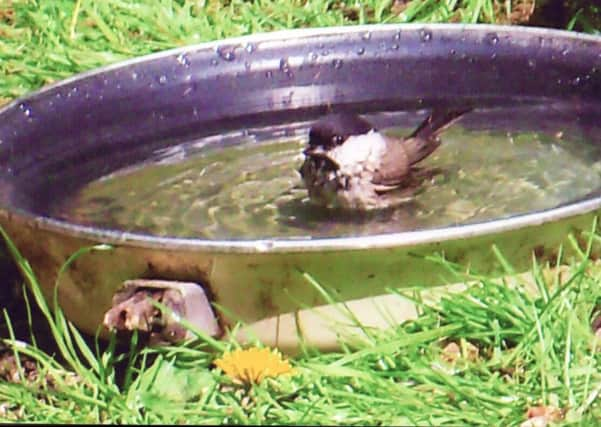Tiny machinegun sound of the marsh tit


There are two of them and the hen is building her nest in an old oak tree nearby where a branch was wrenched off by the ‘87 hurricane.
The cock bird has been singing away giving that percussive tick-tick-tick-tick call which is unmusical perhaps but very territorial.
Advertisement
Hide AdAdvertisement
Hide AdIt sounds like a tiny machine gun. This pair have been with us all winter, together with a pair of cole tits and sundry great, blue, and long-tailed tits.
This week a chiffchaff arrived by the frying pan for a bath. But it was too timid to plunge into that full inch of water.
It would be way out of its depth. So it sat on the grass and went through the motions of bathing. Quite soon a song thrush came by and splashed gladly.
They are lively now because the wet winter gave plenty of mud which meant lots of snails to eat.
Advertisement
Hide AdAdvertisement
Hide AdThe chiffchaff got itself in close to the thrush and when the water started to cascade in all directions the little warbler just sat there and had a shower without the effort of providing the waterworks.
Then there was so much water on the grass a pair of goldfinches bathed in the droplets.
With a whirr and a flurry six siskins hurtled out of the sky having seen the fun in the frying pan from afar.
They were feeding on the seeds falling out of the larch cones, as well as pollen in the hazel catkins.
Advertisement
Hide AdAdvertisement
Hide AdHow bright yellow is the strip on their wings, almost larger than the wing bar on a greenfinch. Also, with that black crown and yellow chest and rump and tail bars the cock siskin almost resembles a canary.
Blackbirds, nuthatches, dunnocks, robins and house sparrows all come to my frying pan and quite empty it every day.
There is no other water for half a mile in all directions. I have watched for crossbills but have not seen one in the garden this year.
They nest in January and the broods are free flying by now. But normally I record 25 species of birds using the frying pan, during the year. Two birds which do not want to bathe are whens and goldcrests.
Advertisement
Hide AdAdvertisement
Hide AdThey are so tiny that heat loss is a serious problem and they dare not risk getting wet.
I suspect that badgers and foxes drink at night since I see their tracks close by in the mud. I have had a roe deer drinking and many years ago fallow deer used to drink from the frying pan as they get very dry in summer when all the water in wheel ruts has vanished.
Once upon a time back in the 1970s I even reared 40 mallard in the garden and you can imagine what a business it was keeping the frying pan full for them.